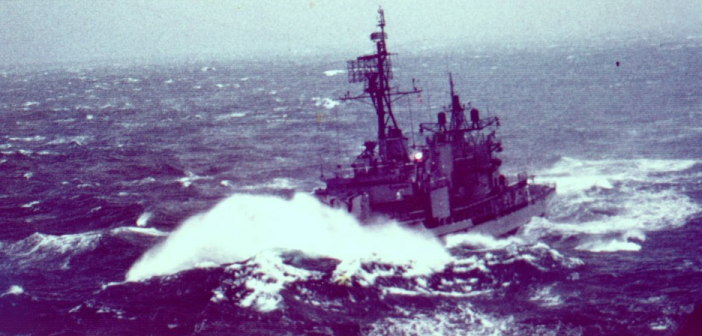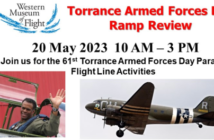The Sea; calm, peaceful, tranquil or, perhaps the ferocity of a typhoon! Here it tries to swallow our escort destroyer. The DD’s bow raises out of the water. You can see air underneath her as her bow lifts skyward on a crest of a huge wind driven swell. She hangs there as if in a determined defiance of gravity. Behind the crest a deep trough forms and reluctantly her bow drops in a plummeting dive, driving her main deck under the next onrushing crest. She submerges as unknown tons of water crash into the flat superstructure and foredeck 5-inch gun mount, and for a brief moment her forward motion almost appears to shutter to a halt. Her huge inertia and buoyancy battle the sea’s grip. Her bow emerges as her awash decks gasp for a breath of air before the next deep trough tries to take her under again.
My carrier moans and groans and screeches in vehement protest making dreadful noise I didn’t know steel could emit, and I look down through my camera lens and feel relief that I am not on that all-too-small destroyer!
The South China Sea storm was by now at its ebb after a long night. This old WWII aircraft carrier exercised her expansion joints and worked by the uneven violent rollercoaster pounding of the wind and waves. On her old but still tough hull she was able to rest before the next experience from the natural elements.
I had a mid-watch during the worst of it. The sleep robbing mid-watch was from midnight to 0400, or 4 am in landlubber talk. After less than two hours sleep I was awakened in my rack, as prearranged, for the watch. I had drawn a forward flight deck watch. The flight deck was normally divided into three sections: Fore, Mid and Aft. The sailor assigned “watch” would walk his assigned area of the flight deck to check aircraft security, tie-down chain tension, fuel leaks, fire, loose objects, anything out of the norm.
Tonight, was different. Tonight, I worked to maintain my balance as the mighty ship heaved and dodged and bobbed in the unrelenting seemingly angered sea. I ascended the ladder to the hangar bay and walked like a candidate for a sobriety test, trying to maintain reasonable semblance of an upright humanoid without knuckles dragging on the hangar deck. I climbed the grooved steel stairway of the un-working escalator from the Hangar Bay to the Island, perched on the starboard side of the flight deck.
Within the protection of the island, we were issued yellow slickers complete with hats that gave us the appearance of Gloucester fishermen fighting a nasty blow in a teaming frothy Atlantic gale. Years later the movie “The Perfect Storm” would refloat an upwelling of memories of my time with the sea.
The watch was modified to adjust for the weather hazard. We would walk the watch teamed with another man, and the flight deck was cut in half, rather than thirds, to pair us up with a fourth man pulled from the hangar bay watch. We were issued a rope as a lifeline to our partner for some false semblance of safety should one of us get blown off his feet fighting the ravages of the storm.
The ship, in a state of war as well fighting the elements, was blacked out, adding another frightful dimension to the harsh biting wind driven rain, and heaving flight deck. Unseen hazards in the dark seem to leap out at you. The gray ghostly form of sharp trailing edges of wings and horizontal stabilizers emerge to mash your face or downturned skull. Tie down chains rise to trip you, while securing the aircraft you we were tasked to babysit in the dread of that extremely wet and wild pitch-black night. You could not look forward as the storm driven water droplets felt like steel shot from a nail gun against any exposed flesh.
Walking toward the bow to check security of the A4 Skyhawks of the VA-192 “Golden Dragons” and F8 Crusaders of the VF-194 “Red Lightning”, we were stooped over. Our bodies bent at angles not normal and totally unfamiliar, as we seemingly climbed, groped and battled our way blindly forward against the on-slot of the ravaging torrents of wind and water.
Green water threatened to cascade over the high pitching flight deck, as the mighty ship plunged forward in the tempest. The fear of losing your tenuous footing and getting blown or swept overboard was suppressed by the reality of your mental resources being otherwise occupied by the challenges of doing the job tasked in that wet and wicked weather.
0400 came. I don’t know where the hell it came from, but it was most welcome when I was at last relieved, and after toweling off, the two more hours sleep in a dry windless and rolling rack was absolute heaven.
These violent days in action against nature were good days at sea.
Even as we fought the elements and managed our task at hand, we were secure in our knowledge that all on board were safe. We would have time later to mourn the count of 7 lost aviators and one seaman who would not return home from the USS Bon Homme Richard’s 1965 cruise. On this night no target was visited on Vietnamese soil. No napalm nor general purpose ordinance was delivered by the mighty winged machines of war chained down to her wet and wild flight deck.




